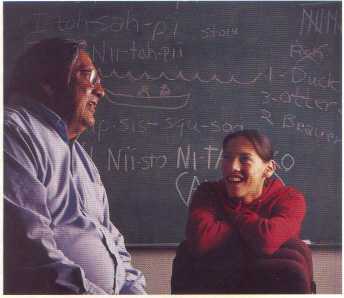Tribal Talk
Immersion schools try to revive and preserve!
Native American Languages -
JESSE DESROSIER begins each school day like lots of kids. The eighth grader hangs up his coat, pulls off his muddy boots and lopes into his classroom, raising a hand in greeting. Then he opens his mouth, and out comes a small miracle.
'Oki, aahsaapinakos!'
Hello, good morning! Bantering easily in the drawn-out vowels and clipped endings of a nearly extinct language, Jesse and his 35 classmates are the first fluent Blackfoot speakers in more than two generations. Here at the Nizipuhwahsin, or Real Speak School, on the BlackFeet Reservation in far north western Montana, the kids spend all day speaking their ancestral tongue.
From kindergarten through eighth grade, they study math, reading, history and other subjects in Blackfoot.
'Some people think our language is dead, but it's not,' says DesRosier, a lanky teenager with a ready grin and dark, narrow braids that reach the middle of his back. 'We still have our language and we're bringing it back.'
What's at stake is more than words. Filled with nuance and references to Blackfeet history and traditions, the language embodies a culture. 'The language allows kids to unravel the mysteries of their heritage,' says Darrell Kipp, director of the school and one of its founders.
The Blackfoot language, also known as Piegan, has been in danger of disappearing for nearly a century From the late 18oos through the 1960s, the Bureau of India n Affairs forced tens of thousands of Native Americans into English-only government boarding schools. Taken hundreds of miles from the reservations, the children were often beaten for speaking native languages and sent home ashamed of them. As adults, they cautioned their own children to speak English only.
n Affairs forced tens of thousands of Native Americans into English-only government boarding schools. Taken hundreds of miles from the reservations, the children were often beaten for speaking native languages and sent home ashamed of them. As adults, they cautioned their own children to speak English only.
'We were told, 'You'd be better off learning only English, so what happened to us won't happen to you,' says 68-year Cynthia Kipp, whose grandchildren attend Real Speak.
Over the decades, many tribal languages fell silent. Of the 300 languages spoken in North America at the time of European settlement, 150 have disappeared completely, and only a handful of the survivors are acquiring new speakers. By 1980, the remaining Blackfoot speakers were more than 50 years old, and Blackfoot was headed down the well-worn road to oblivion.
But in 1982, Darrell Kipp, now a Harvard graduate and technical writer (and distant cousin of Cynthia Kipp), moved back to the reservation wind blown plains after a 20-year absence. He met up with Dorothy Still Smoking, who had also returned, in 1979, after earning a master's from the University of South Dakota, to become a dean at the reservation's community college. Both wanted to learn the language they'd occasionally heard but rarely spoke as children. 'There was al ways a missing piece in my life,' says Still Smoking, 54, 'and that was the cultural component. The language contains everything'our values and wisdom, our outlook on the world.'
In 1987, Kipp, Still Smoking, and a fluent Blackfoot speaker named Edward Little Plume, 73, founded the non profit Piegan Institute, dedicated to restoring Blackfoot and other tribal languages. Because many people on the reservation still associated their language with humiliating experiences at boarding school, the institute was controversial. 'We met people who could not only not speak the language but also had a negative view of it,' says Kipp.
To calm the waters, Kipp, Still Smoking and Little Plume made a video about tribal elders' experiences with the language and distributed 2,000 copies among the reservation's 7,000 residents. The video did the trick. 'People realized we didn't give up the language by choice,' says Kipp. 'Our parents and grandparents didn't pass it on to us because they didn't want us to be abused.'
Now Kipp and his colleagues had to figure out the best way to teach fluency. Though some local high schools had offered tribal language classes for years, these brief encounters taught familiarity not fluency. 'I'd teach the numbers up to five, and by the next week they'd have forgotten them,' says Arthur Westwolf, a Real Speak teacher who worked in the reservation's public schools for 18 years.


 Supporters say the impact runs deep. 'This is away to heal the identity confusion that so many of our students go through,' says Joyce Silverthorne, a tribal education director and member of the Montana Board
Supporters say the impact runs deep. 'This is away to heal the identity confusion that so many of our students go through,' says Joyce Silverthorne, a tribal education director and member of the Montana Board